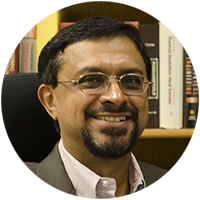Sutanu Sarkar

Sutanu Sarkar received his B. Tech from IIT Bombay, M. S. from Ohio State University and Ph. D. from Cornell University. After 4 years as a staff scientist at ICASE, NASA Langley Research Center, he joined UCSD where he is currently the Blasker Professor of Engineering. He has broad interests in turbulence simulation and modeling and has worked in problems concerning the environment, energy, aerospace and propulsion. His current research interests are routes to turbulence and mixing in the ocean, wakes and boundary layers in the natural environment, and renewable energy. He has received a NASA group achievement award (1994), the Bessel Award from the Humboldt Foundation (2001), and was elected Fellow, American Physical Society (2006), Associate Fellow, AIAA (2009) and Fellow, ASME (2010).
Turbulence at rough topography in the deep ocean
Turbulence is essential to maintain the observed stratification in the abyssal ocean and also strongly impacts the biogeochemical state of the ocean. Tidal flow over rough topography in the deep ocean generates internal gravity waves with a fraction of the wave energy breaking down into local turbulence at the generation site and the remainder radiating away to fuel remote turbulence. We have performed high-resolution simulations to examine nonlinear processes and turbulence in two model generation sites: a triangular ridge and a multiscale rough obstacle that is patterned after realistic topography in Luzon Strait. Different flow features are found to be responsible for transition to turbulence at different spatial locations and lead to energetic turbulence at different phases of the oscillating tide. I will discuss how the local dissipation of energy depends on environmental forcing and topography parameters.
